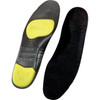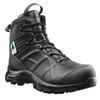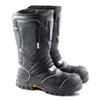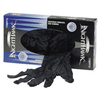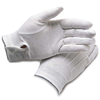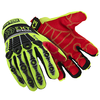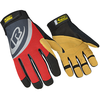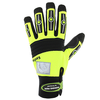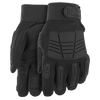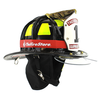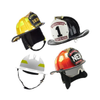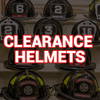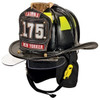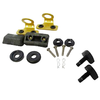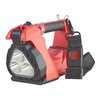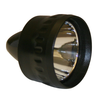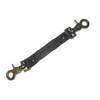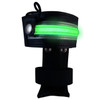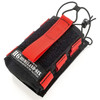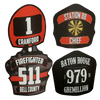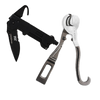LIGHTWEIGHT LAW ENFORCEMENT GEAR
Posted by Jerry Snyder on Apr 23rd 2024
DROP WEIGHT TO INCREASE PERFORMANCE.
WHY WEIGHT MATTERS
In the short term, the weight of your gear will affect how long and hard you’re able to physically exert yourself. Running with no gear is challenging enough, add 30 pounds of equipment and it becomes painful. Wrestling with a non-compliant suspect will deplete your energy even more quickly. When your gear weighs less you can stay in the fight for longer.
Over the long term, heavy gear can take a heavy toll on your health. Back and hip issues are common in officers who carry all their equipment on their duty belt. Lighten the load today and your spine and joints will thank you at the end of your career. Even if you only cut a few ounces out of each category of gear it will still add up. As the military guys say, “ounces equal pounds, pounds equal pain.”
Keep reading to learn about some of the ways you can cut weight off your kit.
LIGHTWEIGHT LE GEAR
Patrol Rifles
The heaviest component of most rifles is the barrel. Choose a patrol rifle with a shorter barrel and a “pencil” barrel profile for maximum weight savings. Some manufacturers like LWRCI cut “flutes” into their barrels to shave some excess weight off while.
The handguard is another place where you can save weight. If you don’t run a night vision ready setup, you probably won’t need a handguard with a full-length top rail. A polymer handguard like the Magpul MOE M-LOK Handguard saves weight without losing the ability to mount lights and slings.
Using a factory short barreled rifle (SBR) will save weight on both the handguard and the barrel right out of the box. For example, the Springfield Edge AR-15 is sold in 11.5” or 16” configurations, the 11.5” barreled rifle weighs 9 ounces less.
The action type for your rifle will also contribute to its weight. Direct impingement (DI) gas systems typically weigh less than a piston system.
Stocks like the Mission First Tactical Battlelink or the Daniel Defense Buttstock will save you a couple of ounces compared to the mil-spec M4 stocks that come with most patrol rifles.
Optics can add considerable weight to your firearm, especially magnified optics. Magnified optics like LPVOs (Low power variable optics) provide incredible tactical advantages but come at the cost of weight. All those pieces of glass in the tube add up, when you add a sturdy mount, you’re looking at least an extra pound and a half on the top of your rifle! Most patrol officers are already running a red dot or holographic sight like the EOTech EXPS 3, add one of their lightweight magnifiers to boost your long-range performance without adding too much weight.
Duty Pistols
When it comes to your handgun, the single most important factor that impacts the overall weight of your weapon is the material that makes up the frame. All steel guns like 1911s or revolvers will weigh considerably more than polymer framed pistols. Let’s compare the Sig P226 and the Glock 47. Unloaded, the Sig P226 weighs 34 ounces, just over 2 pounds! Unloaded, the Glock 47 weighs about 23 ounces.
Another factor that comes into play is the caliber your weapon is chambered for. A single 230 grain .45 ACP round weighs about .7 ounces, a single 124 grain 9mm will weigh around .45 ounces. If you normally carry 51 rounds in reserve (3 extra 17 round mags) you’d be looking at a 12.75 ounces difference overall, not counting the weight of the magazines.
An essential accessory that contributes to the weight of your pistol is your weapon mounted light. Let’s compare the Streamlight TLR-1 HL to the TLR-7A. The TLR-1 HL weighs in at 4.2 ounces while the 7A weighs in at 2.4 ounces. Not an enormous difference, but remember “ounces equal pounds, pounds equal pain.”
The last point we’ll touch on is optics. Equipping duty pistols with red dot sights is becoming the norm among law enforcement agencies. Not only do they increase shooting performance, but they increase weight. Most red dot optics only weigh 1-2 ounces, compact sights like the Holosun 407K weigh closer to one ounce while large optics with big windows like the Trijicon RMR HD come in closer to 2 ounces. The advantages gained from using a red dot definitely outweigh (ha) the added ounces.
Lights
How much does your handheld weigh? We have come a long way in terms of lighting technology since the days of D-cell Maglites with incandescent bulbs. Lights like the Streamlight Stinger 2020 (12.3 ounces) maximize light output (2,000 lumens on high mode) while maintaining a low weight. If you don’t mind a smaller light, the Streamlight ProTac HL-X puts out an impressive 1000 lumens while weighing only 6.2 ounces. For Everyday Carry (EDC) or plainclothes carry a super compact light like the Streamlight Wedge won’t weigh you down (3 ounces) or compromise on lumens (1,000 on THRO mode).
Duty Boots
Boots weight can vary widely weighing anywhere from 1 to 4+ pounds and it’s not easy to find the weight specs on them while you’re shopping. That said, there are some tricks you can use to find lighter weight boots:
1. Take materials into account: All leather boots often weigh more than boots that utilize synthetic materials. Steel safety toes will add significant weight to the boots, consider buying a pair with a composite toe to save weight.
2. Visit our showrooms: Try them on in person and compare weights with your current boots. Click here for a list of our locations.
3. Give us a call: In our system we can check the weight of the boots with the packaging included to give you a rough estimate. Toll Free: 610-857-8070
4. Schedule a demo: If your agency is located within a territory covered by one of our law enforcement specialists, we can visit your department with a box of boots for your officers to try on. Fill out a request form here.
Police Batons
Our selection of ASP (Armament Systems and Procedures) expandable batons come in two flavors: aluminum and steel. The aluminum batons like the airweight or lightweight will weigh about 45% less than their steel counterparts. In addition to being noticeably lighter, ASP Airweights move more rapidly than steel batons. They allow a faster "bridge" between strikes. The length of the baton will also contribute to its overall weight; for example, the 26” ASP Sentry Baton will weigh more compared to the 16” version. For administrators, investigators, and undercover officers who do not need or want a large baton, the ASP P12, P16, or Agent series will fit your needs. These ultra compact batons can be concealed in almost any outfit and weigh less than half a pound.
Handcuffs
Your handcuffs are another place where you can save weight. Peerless makes a lightweight version of their legendary 700C series cuff called the 730CS Superlite. The Superlite cuffs weigh 5.2 ounces while the standard 700C cuffs weigh 10 ounces! If you carry two sets of handcuffs, consider swapping your backup cuffs for a pair of disposable zip cuffs like the Jersey Tactical Jersey Cuff or the ASP Tri-Fold cuffs. The polymer zip cuffs are more compact and weigh considerably less than traditional metal cuffs.
The Aluminum ASP Ultra Cuffs are another great option for lightweight cuffs. Not only are they lighter weight, but they come with a host of other upgrades to increase ease of use like:
Recessed keyway
Two-sided double lock
Double lock indicator (colored)
Two-sided lock release
Duty Belts
Traditional Duty belts use leather, more modern options like the 5.11 Sierra Bravo Duty belt have the same functionality with reduced weight from the nylon construction. If you don’t want to compromise on the leather aesthetic, you could opt for a synthetic leather belt like the Gould & Goodrich L-Force Sam Browne Duty Belt which weighs less AND costs less.
One piece of gear that will drastically change how your duty belt's weight is distributed is suspenders. Suspenders move weight from the hips to the shoulders and upper back. The Wesol Tactical Duty Belt Undergarment Suspender can even snake into uniform shirts to hide the straps from view. If the look of external suspenders is not frowned upon at your agency, you could choose to rock the Boston Leather Policeman Leather Suspenders loud and proud.
The pouches on your duty belt add up! The difference in weight from a classic design like the Safariland 775 Triple Mag Pouch and the Blue Force Gear Ten-Speed Mag Pouch is drastic. Blue Force Gear pouches weigh next to nothing and can be attached to belts or MOLLE.
High Speed Gear TACO pouches are worth a mention as well. Their new Duty line of TACOs feature sleeker fronts for a slicker look and are extremely adjustable to fit any type of magazine, all while weighing in at .103 pounds!
Ballistic Vests
There is a lot to talk about in regard to body armor. Most officers are typically issued soft, concealable, level IIIA armor like the Point Blank Elite Carrier. We suggest not going below level IIIA protection due to the effectiveness of modern ammunition. Once again, materials matter the most.
Steel armor is popular in the civilian market due to its low cost, but its major disadvantage is its weight, a single level III plate could weigh 10 pounds!
The best weight to protection ratio can be found in UHMWPE (Ultra High Molecular Weight Polyethylene) / Ceramic plates like the Paraclete Speed Plate Plus, weighing in at 4.8 pounds per plate AND offering rifle rated protection! Consider what threats will be common in your area, while level IV protection sounds great on paper, when you run around for hours with those 8lb plates in your carrier you’ll be rethinking if you really need protection from 30-06 armor piercing rounds. Level III protection covers the most common rifle calibers in the USA like 5.56x45 and 7.62x39 and typically weighs less.
If you typically use an outer carrier to hold your gear, make sure to balance the weight. If you have all your heavy items on one side of the carrier, then you are introducing an imbalance that could impact your long-term health and performance in the field. Refer to the previous section covering duty belt pouches for some brands to browse when selecting pouches for your carrier.
Conclusion
That was a lot to cover, and we didn’t even cover it all! If you have any questions, want to test and evaluate any equipment, or want to get quotes on lighter weight gear, contact our team of law enforcement specialists. Thank you for reading, good luck out there!


